Unity Technologies unveils Unity 2020 product roadmap
Originally posted on 27 September 2019. There is now an updated roadmap video here.
Unity Technologies has unveiled its 2020 product roadmap for Unity, its game engine and development environment, at this week’s Unite Copenhagen 2019 user event.
Unity 2020.1, the first update in the release cycle, will introduce a new visual scripting system, plus performance and workflow improvements to the Unity editor.
It will also add a range of animation features, including a ‘freeform’ runtime animation system, and Kinematica, a new machine-learning-based system for generating animated characters from raw motion data.
Graphics changes include support for the Arnold Surface Shader and 3ds Max Physical Material in the Scriptable Render Pipeline, and a new eye shader in the High Definition Render Pipeline.
Features due later in the 2020 release cycle include a new non-destructive layer-based environment system, virtual texturing, and further changes to Unity’s user interface.
More details on the new features in Unity 2019.3 in our other stories
In his Unite Copenhagen session, Will Goldstone, Unity Technologies product manager for workflow and design, covered both the new features in Unity 2019.3, currently in beta, and in the 2020 series.
We’ve already covered Unity 2019.3, so check out our story on the beta release for more details, and our story on the Unite Copenhagen 2019 keynote to see some of those features in action.
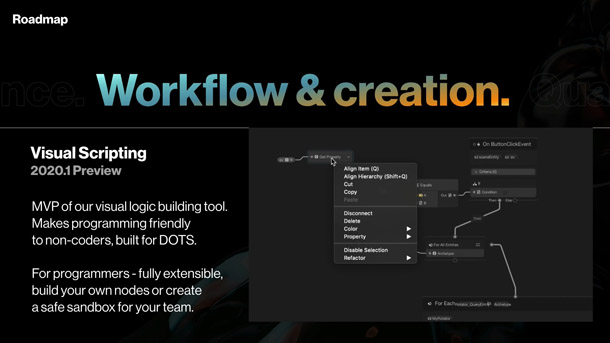
Unity 2020.1: ‘MVP release’ of the long-awaited visual scripting system
New features in Unity 2020.1 include the long-awaited visual scripting system – originally scheduled for the 2019 release cycle – and described as a minimum viable product in its initial release.
The system, which has been redesigned for DOTS, Unity’s multithreaded coding framework, lets non-coders program Unity game systems by wiring together nodes in a graph.
It generates C# code for runtime, with edits made to the graph being reflected in real time in Play Mode.
Unity 2020.1: preview releases of new animation systems
New animation features in Unity 2020.1 include Kinematica, a new machine-learning-based system for generating animated characters at runtime, originally announced at Unite Berlin last year.
Described as “removing the need for state machines in certain use cases”, Kinematica uses motion synthesis to generate the motion of a character from a set of raw, unstructured animation data.
The system enables artists to provide a set of mocap or keyframe animation clips and have Kinematica blend between them based on player input, rather than having to set up a blend tree or animation graph.
The release will also extend Unity’s Animation Rigging package to support “freeform” workflows.
Added in preview in Unity 2019.1, the system enables users to generate procedural animation for a character at runtime based on a set of rig contraints.
In the 2020.1 update, it will also be possible to blend in motion-capture data or keyframe animation, increasing the scope of the animation that can be created.
Unity 2020.1: new rendering and 2D graphics features
New graphics features in Unity 2020.1 include support for shadow masks and deferred rendering in the Universal Render Pipeline – the new name for the mobile-focused Lightweight Render Pipeline.
Its console and desktop-focused counterpart, the High Definition Render Pipeline, gets a new eye shader, alongside the other digital human shaders announced with The Heretic, Unity’s new rendering demo.
Native support for Arnold’s Standard Surface shader and 3ds Max’s Physical material has also been added to the Scriptable Render Pipeline, the technology underlying both the URP and HDRP.
Support for both materials is being added to the old built-in render pipeline in Unity 2019.3.
The new 2D tools introduced in Unity 2019.2 – there’s a nice demo in the Unite Copenhagen keynote – also get further updates, including experimental support for soft shadows in the 2D renderer.
Sprite tiling system Sprite Shape gets support for deformation-based shapes, while the 2D Tilemap system gets support for 2D shadows and “improved scriptable brushes”.
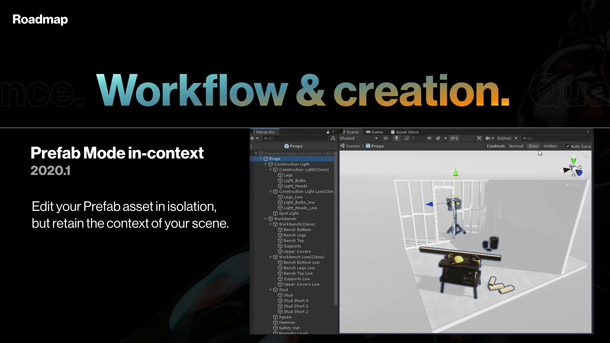
Unity 2020.1: workflow and performance improvements
Workflow changes in Unity 2020.1 include the option to display assets in context inside Prefab Mode.
As well as isolating individual Prefab Assets during editing, users can now choose to display surrounding objects from the level, either grey-shaded, or with full textures.
Under the hood, performance of the Unity editor has been improved: at 09:00 in the video, you can see a comparison of frame rates when selecting 10,000 cubes in the viewport in Unity 2019.2 and Unity 2020.1.
Unity 2020.1: coding tools and other features
Unity 2020.1 will also feature Entities 1.0, the production-ready versions of the underlying systems from the DOTS coding framework: the C# job system, the Entity Component System and the Burst compiler.
DOTS will also get preview packages for experimental new netcode and audio functionality.
The summary slides from the presentation also list updates to Cinemachine, Unity’s procedural camera system, and Timeline, Unity’s cinematics editor, the latter increasing customisability and “addressing user pain”, though there was no detailed information about either.
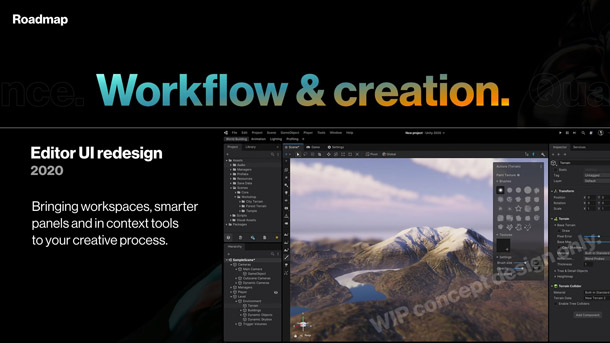
Unity 2020 cycle: ongoing UI redesign
The Unity 2020 release cycle will also see continuation of the redesign of the interface of the Unity editor, begun in Unity 2019.3.
Although the design shown in the image above is still a prototype, it shows some of the key aims of the work, including the option to float tools panels over the scene view.
The redesign will also introduce a set of workspaces with separate UI layouts tailored to for different tasks, like world building, animation and lighting.
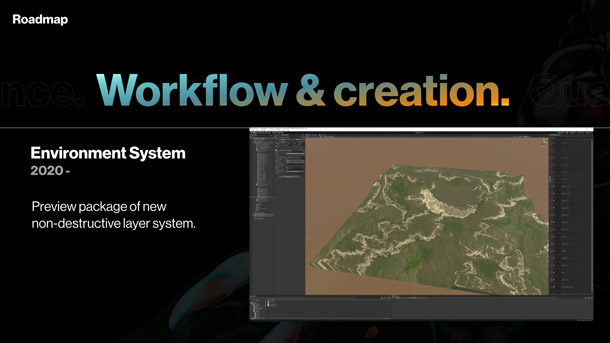
Unity 2020 cycle: new environment system
Other new features scheduled for the 2020 release cycle – the timing isn’t specified, so they could be in Unity 2020.2 or Unity 2020.3 – include a new non-destructive environment system.
The new workflow will make it possible to create and edit environments in layers, helping multiple artists within a studio to work on a level in parallel without their edits conflicting.
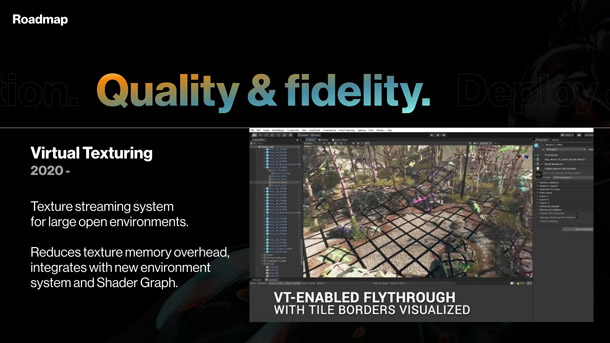
Unity 2020 cycle: Project Tiny and virtual texturing
Other features scheduled for 2020 include the production release of Project Tiny, Unity’s modular system for building fast-loading mobile and HTML5 games, released in preview in Unity 2018.3.
Unity will also support virtual texturing, making it possible to load in only those parts of a texture visible in the viewport on the fly.
The system, also recently introduced in Unreal Engine 4.23, makes it possible to use larger textures than would otherwise fit into GPU memory, and improves interactive performance.
Unity’s implementation is based on the Granite SDK developed by Graphine, the third-party developer which Unity Technologies acquired earlier this year.
Pricing and system requirements
Unity Technologies hasn’t announced release dates or any pricing changes for Unity 2020.1 or the other updates in the Unity 2020 release cycle yet.
Unity 2019.3 is currently available in beta for Windows 7+ and macOS 10.12+.
Unity is available on a rental-only basis: free Personal subscriptions have a non-removable splash screen and can be used by anyone with revenue of up to $100,000/year.
Paid Plus and Pro plans currently cost $35/seat/month and $125/seat/month respectively.
Find more details of the Unity 2020 product roadmap in the slide deck from Unite Copenhagen
